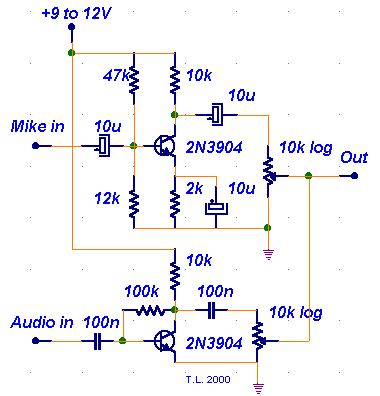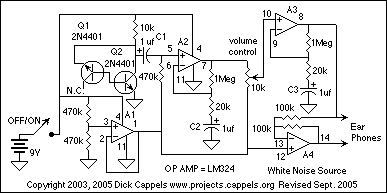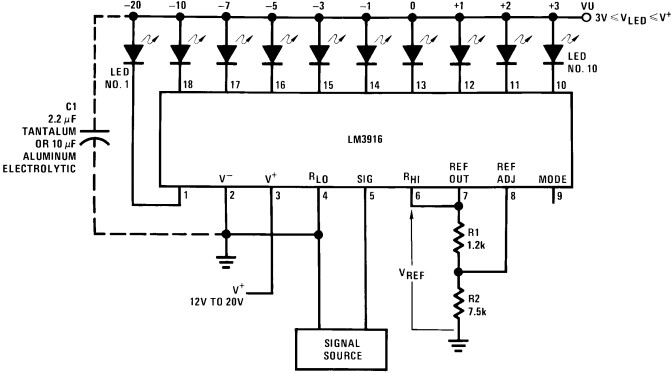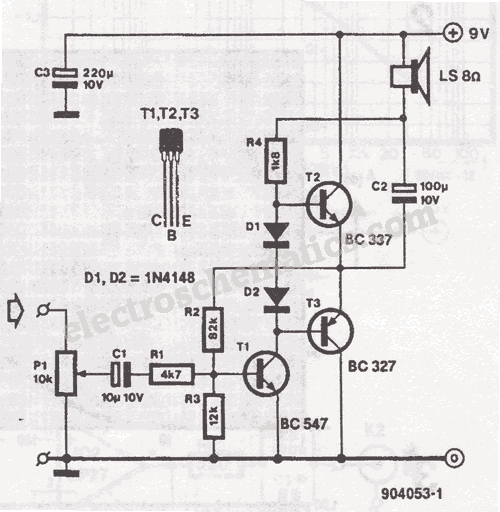
2 INPUT AUDIO MIXER with 2N3904

The mixer consists of two transistor-based preamplifiers. The first one, designated as "Mike," provides high gain and is designed to work effectively with a standard dynamic microphone. The second preamplifier can be used to control audio input from a tape recorder or CD player.
The mixer circuit utilizes two transistor preamplifiers to amplify audio signals from different sources. The first preamplifier, referred to as "Mike," is optimized for use with dynamic microphones, which are commonly used in live sound applications due to their durability and ability to handle high sound pressure levels. This preamplifier is designed to provide a high gain, allowing for clear and strong audio signals to be captured from the microphone.
The second preamplifier is intended for use with line-level audio sources, such as tape recorders or CD players. This preamplifier is configured to accept audio signals that are already amplified to a certain degree, ensuring compatibility with various audio playback devices. The circuit design allows for seamless integration of these two audio sources, enabling users to mix them effectively.
In terms of circuit design, each preamplifier typically includes biasing resistors to set the operating point of the transistors, coupling capacitors to block DC voltage while allowing AC audio signals to pass, and possibly feedback resistors to stabilize gain. The output of each preamplifier can be combined using resistive mixing techniques, ensuring that the final mixed output maintains audio quality without distortion.
The layout of the circuit is crucial for minimizing noise and interference, which can degrade audio performance. Careful consideration should be given to the placement of components, grounding techniques, and the use of shielded cables for audio connections. Overall, this mixer circuit provides a foundational approach to audio mixing, suitable for various applications in both live sound and recording environments.As simple as it gets. The mixer consists of two transistor-based preamplifiers. The aboriginal one (designated Mike in ) offers college gain. it works able-bodied with a approved activating microphone. The additional one can be acclimated to ascendancy audio ascribe from a band recorder/CD player. [. ] 🔗 External reference
The mixer circuit utilizes two transistor preamplifiers to amplify audio signals from different sources. The first preamplifier, referred to as "Mike," is optimized for use with dynamic microphones, which are commonly used in live sound applications due to their durability and ability to handle high sound pressure levels. This preamplifier is designed to provide a high gain, allowing for clear and strong audio signals to be captured from the microphone.
The second preamplifier is intended for use with line-level audio sources, such as tape recorders or CD players. This preamplifier is configured to accept audio signals that are already amplified to a certain degree, ensuring compatibility with various audio playback devices. The circuit design allows for seamless integration of these two audio sources, enabling users to mix them effectively.
In terms of circuit design, each preamplifier typically includes biasing resistors to set the operating point of the transistors, coupling capacitors to block DC voltage while allowing AC audio signals to pass, and possibly feedback resistors to stabilize gain. The output of each preamplifier can be combined using resistive mixing techniques, ensuring that the final mixed output maintains audio quality without distortion.
The layout of the circuit is crucial for minimizing noise and interference, which can degrade audio performance. Careful consideration should be given to the placement of components, grounding techniques, and the use of shielded cables for audio connections. Overall, this mixer circuit provides a foundational approach to audio mixing, suitable for various applications in both live sound and recording environments.As simple as it gets. The mixer consists of two transistor-based preamplifiers. The aboriginal one (designated Mike in ) offers college gain. it works able-bodied with a approved activating microphone. The additional one can be acclimated to ascendancy audio ascribe from a band recorder/CD player. [. ] 🔗 External reference





